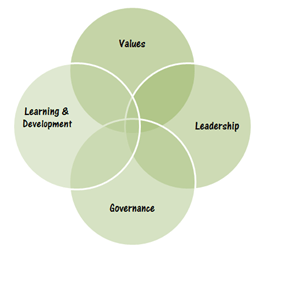According to Vardi and Winer (1996), workplace culture is “widely regarded as a construct denoting the extent to which members share core organizational values” (Vardi & Wiener, 1996, p. 160). In 2003, Boucaut described organisational culture as a potential barrier to resolving face-to-face workplace challenges; these can include workplace bullying, harassment and work safety. In large organisations, culture is expressed through explicit and implicit rules, both of which are recognised as key elements that can enhance, or reduce, employee engagement.
Corporate or Organisational Culture |
Explicit culture (rules) | | Implicit culture |
| Reflected by a workplace code of behaviour conduct, sometimes referred to as a code of ethics that are articulated through local and/or national legislation such as work health safety laws. Corporate governance is enlivened through explicit mechanisms and processes that control and direct organisations, and include policies, rules, procedures and frameworks that distribute employees’ rights and responsibilities. These frameworks can be participatory or exclusionary (Peters, 2004). | | Exists along-side the explicit, legislated rules governing corporate codes of conduct and ethics, and are the shared values attitudes, norms, assumptions and accepted behaviours of a group or team that are often described as the “the unwritten rules” (Boucaut, 2001; Crawford, 2001). An organisation’s unspoken and implicit rule could be, “we are proud of our Can Do culture, so we put up with workplace bullying behaviour because that’s how we deliver results.” Implicit culture has the potential to reduce or undermine explicit rules, such as work health safety and anti-bullying legislation and policies. |
Changing organisational culture through mobile technologies
According to the 2013 Fusion Conference, senior technology leaders issued a Service Management Call to Action stating, “Fundamental [workplace] transformation is needed.”
Online workplace cyber communications are seen as transforming traditional forms of organisational communication with fast-paced and sometimes impersonal workplace text-based interactions that not only reduce response times but can increase workplace stress, and often enhance the potential for miscommunication (Sproull, 1994).
Mobile technologies indicate a social revolution is changing both organisational cultures and job expectations, and conventions around employee management (Coovert & Thompson, 2003). In this changing environment, good work safety practices are essential.
Engaging a dis-engaged workforce
Research consistently identifies four elements that help employees to re-engage. These are values, leadership behaviours, governance, and learning and development.

Explicit values
Employees are more likely to leave organisations that exhibit systemically inequitable and unsafe employee management governance procedures (culture) and obvious levels of conflict and bullying (Einarsen, Hoel, Zapf, & Cooper, 2011). Integrated organisational cultures that explicitly align with corporate goals enable employees to see how their agency’s direction and vision fits with their personal values and personal behaviours, leading to better workplace engagement and performance.
Leadership
If you want others to own the culture, you have to act in such a manner that shows others that you live the culture. A safety culture is a living culture and, to be credible, must keep the respect and trust of staff and stakeholders. This credibility is upheld by senior leadership and management groups modelling the behaviours they wish to see across their organisation, and quickly discipline individuals who breach those values.
Governance
Good governance processes are demonstrated through clear work practices and rules that cohesively cascade through business outcomes (Boucaut, 2001, 2003). Explicit corporate values are therefore expressed through performance management KPIs, monthly and annual employee reward and recognition mechanisms, respectful board and committee processes where individuals listen to one another, and participatory and inclusive change management processes.
Learning and Development
A simple mechanism by which to align explicit corporate values and behaviours with respectful interpersonal communication techniques is to teach these methods through the organisation’s learning and development program. This program can include modules on managing difficult people and situations, active listening, leadership and management, performance management processes, workplace safety and harassment and bullying rights and responsibilities.
The Safety Conversation Podcast: Listen now!
The Safety Conversation with SHP (previously the Safety and Health Podcast) aims to bring you the latest news, insights and legislation updates in the form of interviews, discussions and panel debates from leading figures within the profession.
Find us on Apple Podcasts, Spotify and Google Podcasts, subscribe and join the conversation today!



My father who worked in corporate America almost entirely throughout his career told me this: A company that does not stand behind, uphold and nurture their core values basically has no core values. It’s so easy to make a statement, set core values, have a mission and tag key phrases on posters to support a cultural environment. But walking the walk and talking the talk are another thing entirely. If a company feeds into these basic white noise strategies, they must support them to empower them. In this case, the overwhelming leadership within their organization would need to be massively… Read more »